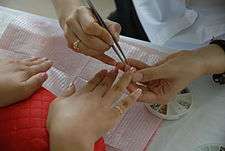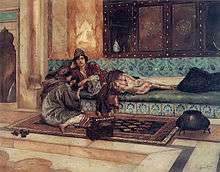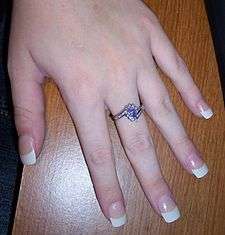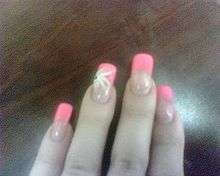Manicure


A manicure is a cosmetic beauty treatment for the fingernails and hands performed at home or in a nail salon. A manicure consists of filing and shaping the free edge, pushing and clipping (with a cuticle pusher and cuticle nippers) any nonliving tissue (but limited to the cuticle and hangnails), treatments with various liquids, massage of the hand, and the application of fingernail polish. When the same is applied to the toenails and feet, the treatment is referred to as a pedicure.
Some manicures include painting pictures or designs on the nails, or applying small decals or imitation jewels. Other nail treatments may include the application of artificial gel nails, tips, or acrylics, which may be referred to as French manicures.[1]
In many areas, manicurists are licensed and follow regulations. Since skin is manipulated and is sometimes trimmed, there is a risk of spreading infection when tools are used across many people. Therefore, having proper sanitation can be a serious issue.
Etymology
The English word manicure comes from the French word manucure, meaning "care of the hands", which in turn originates from the Latin words manus, for "hand", and cura, for "care".[2] Similarly, the English word pedicure comes from the Latin words pes (Genitive case - pedis), for "foot", and cura, for "care".[3]
History
Manicures began 5,000 years ago.[4]
In the United States, the nail care industry is dominated by Vietnamese-American proprietors and nail technicians. In 1975, while visiting with refugees in California, actress Tippi Hedren noticed the women were interested in her Hollywood fashion and makeup. Hedren directed her manicurist to instruct the women in nail care and help them find jobs.
Types
French manicures

Jeff Pink, founder of the professional nail brand Orly, is credited with creating the natural nail look later called the French manicure in 1976.[5]
Nails that have undergone a French manicure are characterized by a lack of artificial base color and white tips at the free edge of the nail. For this reason, they are sometimes referred to as "French tips". The nail tips are painted white, while the rest of the nails are polished in a pink or a suitable nude shade. French manicures can be achieved with artificial nails. However, it is also as common to perform a French manicure on natural nails. Another technique is to whiten the underside of the nail with white pencil and paint a sheer color over the entire nail.
Hot oil manicures
A hot oil manicure is a specific type of manicure that cleans the cuticles and softens them with oil. Types of oils that can be used are mineral oil, olive oil, some lotions or commercial preparations in an electric heater.
Dip powder manicures
Dip powder manicures are an alternative to traditional acrylic nails and gel polish. Dip powders have become popular due to ease of application. They are similar to traditional silk or fiberglass enhancements, with the fiber being replaced by acrylic powder. Both methods rely on layering cyanoacrylate over the natural nail and encasing either the fiber or acrylic powder. While a single layer of fiber is typical, multiple alternating layers of powder and cyanoacrylate may be used in dip nails.
Paraffin wax treatments
Hands or feet can be covered in melted paraffin wax for softening and moisturizing. Paraffin wax is used because it can be heated to temperatures of over 95 °F (35 °C) without burning or injuring the body. The intense heat allows for deeper absorption of emollients and essential oils. The wax is usually infused with various botanical ingredients such as aloe vera, azulene, chamomile, or tea tree oil, and fruit waxes such as apple, peach, and strawberry, are often used in salons. Occasionally, lotion is rubbed on the hand or foot before being coated in paraffin. Paraffin wax treatments are often charged as an addition to the standard manicure or pedicure. They are often not covered in general training and are a rare treatment in most nail salons.
Professional services should not include dipping clients' hands or feet into a communal paraffin bath, as the wax can be a vector for disease. Paraffin should be applied in a way that avoids contamination, often by placing a portion of the wax into a bag or mitt, which is placed on the client's hand or foot and covered with a warm towel, cotton mitt, or booty to retain warmth. The paraffin is left for a few minutes until it has cooled.
Common manicure tools and supplies
Common manicure/pedicure tools include:[6]
- Bowl of warm water or fingerbath
- Cuticle nipper (cuticle knife, cuticle clipper)
- Cuticle pusher
- Foot bath (pedicures)
- Manicure table
- Nail art brushes/tools
- Nail brush
- Nail buffer
- Nail clippers
- Nail file (usually an emery board)
- Nail scissors
- Orangewood stick
- Pumice stone / foot file (pedicures)
- Rubber thimble-like object (used to help open polish)
- Toe separator (pedicures)
Common manicure/pedicure supplies include:
- Cotton balls/pads
- Cuticle remover
- Hand cream
- Hand towels
- Massage lotion
- Mild scrub
- Nail jewels (often self-adhesive)
- Nail polish
- Nail polish remover or nail polish remover wipes
- Base coat polish & ridge filler polish
- Color varnish
- Top coat or sealant
For decoration (optional):
- Fimo/Nail art cane slices
- Flocking Powder
- Glitter
- Sanitizing spray/towels
- Small dried flowers
Sanitation options
In Australia, the United States, and other countries, many nail salons offer personal nail tool kits for purchase to avoid some of the sanitation issues in the salon. The kits are often kept in the salon and given to the client to take home, or are thrown away after use. They are only used when that client comes in for a treatment.
Another option is to give the client the files and wooden cuticle sticks after the manicure. Since the 1970s, the overwhelming majority of professional salons use electric nail files that are faster and yield higher quality results, particularly with acrylic nail enhancements.
Shape

There are several nail shapes: the basic shapes are almond, oval, pointed, round, square, square oval, square with rounded corners, and straight with a rounded tip.[7] The square oval shape is sometimes known as a "squoval",[8] a term coined in 1984.[9] The squoval is considered a sturdy shape, useful for those who work with their hands.[10]
New York controversy
On May 7, 2015, The New York Times journalist Sarah Maslin Nir broke the two-part story titled "The Price of Nice Nails" and "Perfect Nails, Poisoned Workers" about abuses in New York salons related to ill-treatment of workers and associated health risks. As a result, on May 11, 2015, New York governor Andrew Cuomo took immediate measures announcing a Multi-Agency Enforcement Task Force to tackle the abuse in the nail salon industry.[11]
References
- ↑ "What is a French Manicure?". Wisegeek.com.
- ↑ "Manicure definition". Online Etymology Dictionary.
- ↑ "Pedicure definition". Online Etymology Dictionary.
- ↑ "Archived copy". Archived from the original on 2014-11-13. Retrieved 2014-11-13.
- ↑ "Aha! Moment: The French Manicure". Women's Wear Daily.
- ↑ "11 Essential Manicure And Pedicure Tools - Nail Care Equipment". stylecraze.com.
- ↑ Elaine Almond (Sep 19, 1994). Manicure, Pedicure And Advanced Nail Techniques. Cengage Learning EMEA. p. 116.
- ↑ Esla Mcalonan (19 April 2009). "Home beauty school - Founder of Jessica Nails, Jessica Vartoughian, on a proper salon manicure". Mail Online. The Daily Mail, UK. Retrieved 2009-07-23.
- ↑ Crowley, Tim (2007). "Getting Nails Into Shape", Nails, p.81. November issue accessed 02/15/08.
- ↑ Alisha Rimando Botero; Catherine M. Frangie; Jim McConnell; Jacqueline Oliphant (May 28, 2010). Milady's Standard Nail Technology. Cengage Learning. p. 217.
- ↑ Maslin, Sarah (May 7, 2015). "The Price of Nice Nails". New York Times. Retrieved 12 May 2015.
External links
| Wikimedia Commons has media related to Manicure. |
| Look up manicure in Wiktionary, the free dictionary. |